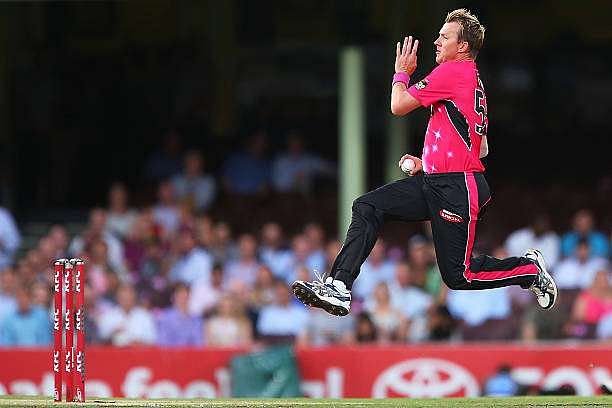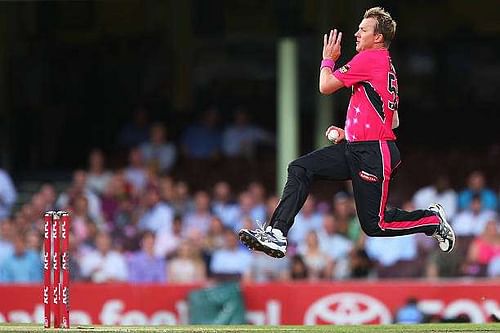
Interview: Kids are training incorrectly on the cricket field, says Brett Lee
The ball sails into the crowds and pandemonium erupts. The batsman, beaming with pride, holds aloft his willow while the bowler, vanquished, searches for a shoulder seeking consolation.
That the gentlemen's game has turned into one dominated by batsmen isn't all too far-fetched a conclusion. But every now and then, like a beacon in the dark, there emerges a ray of hope. And it is when the stumps cartwheel and when a toe-crushing yorker disrupts a leather hunt that we take note.
Fast bowling and its vagaries never cease to enthral us. We marvel at the sights it produces and watch in awe as the exponents charge in, ball after ball. Brett Lee elicited such reactions from fans the world over during his illustrious career. With an action that seemed almost computer generated, he sent down fireballs that intimidated the otherwise trigger happy willow-wielders.
A coach once confessed to me that his hardest task, more often than not, was to get his bowlers to hit the right length. At a chance meeting with Brett Lee, I popped the question and hoped that he'd share the “secret ingredient” – a recipe that was perhaps passed on to him by his Master Oogway.
“I was like a lot of other kids,” he started. “You put a coin down where you want to land the ball". Is that it, I asked myself. But I wasn't to be disappointed, for Lee shed more light soon enough.
“What Glenn McGrath did so well was that he literally smashed that good zone day in and day out. And that's the reason why he picked up so many wickets.”
Lee didn't quite hand me his recipe but I did get a whiff of it. Consistency and precision are often cliched terminologies but the former Australian tearaway swore by them.
“If you can bowl 85-90% of the balls at that high level in Test cricket in the good zone, you're going to take wickets” – just like McGrath, I caught my inner conscious whispering.
“If you're bowling short and the ball goes over the stumps, you're not going to pick up a bowled or an LBW. You might get a caught behind, you might get a chop on but you've only got one form of dismissal to get. Whereas if you know the correct length, you're in business.”
All in the length
Lee couldn't have kept it any simpler. The length was and still is everything in cricket, more so in the T20 version. Yet the bowlers continue to err, leaving fans frustrated and coaches scratching their heads for answers.
The former Australian pacer was quick to make his point. “I was watching the IPL last night, watching the teams warm up and you firstly look at the batsmen - they're doing their throw downs, they're working on their cover drives, their hook shots. Then you look at the bowlers. They're only bowling at one stump. And they don't know where the ball is landing, there's no reference to length, so it's no wonder why you're seeing bowlers bowling toward the death these days just missing their length.”
Why not get these bowlers to use the magical coin Mr. Lee, much like the one that you did as a kid, I was tempted to ask. But being the bowler that he was, he knew I was making room to drive him over covers – he had a comment ready even before I got my footwork going.
"You put a coin down where you want to land the ball, then you run back 30-40 metres but once again, you can't really see that coin from there as it's too far away."
Pity, the coin technique clearly doesn't work anymore. But thanks to the advancements in technology and the increasing presence of data analysts in the dugout, bowlers are able to gauge their line and lengths. With adequate training hours and support, most bowlers do get better.
Also read: Chris Gayle is a top contender for RCB's home games, says Virat Kohli
“Kids are training incorrectly”
“As a young kid, training with my brothers, I just wanted to improve and become a better cricketer. And now, despite so much technology around the world these days, we just look and see that there's nothing out there for bowlers.”
And it is for this reason that he's throwing his weight behind the Bowling Master – a colour coded mat, which when rolled alongside a pitch, provides instant feedback to a mobile app, thanks to sensors.
“Kids are training incorrectly because they don't know and it's not their fault. But this is going to give them the edge and this is one back for the bowlers,” said Lee with a visible smile.
With cricket academies across the world increasingly adopting the technology, I couldn't help but ask if he would've been richer by 150 international wickets should he have had access to such wherewithal as a youngster.
“It would've changed the way that I trained,” he opined. “I would've known early on the correct length to bowl. Bowlers don't have any spot on the wicket where they've been taught to bowl at whereas the batsmen have their checkpoints. They know where their off stump is, whereas the bowler is just asked to run and bowl.”
It suddenly dawned upon me that a young Brett Lee, training with present day technology, could have been a different beast altogether – a rather terrifying prospect for the already traumatised batsmen of his era.
Also read: India should play Hardik Pandya in all three formats, feels Sourav Ganguly
